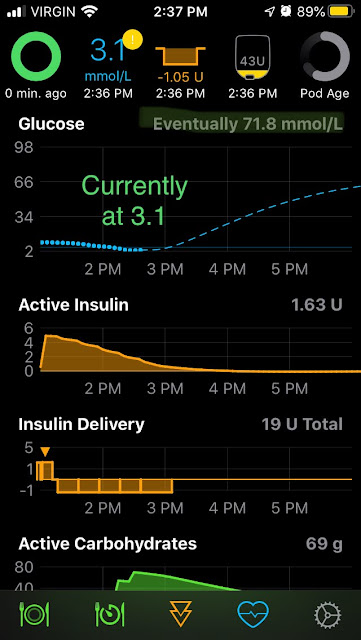JDRF's #AccessForAll Campaign
Do you use a Continuous Glucose Monitor or a Flash Glucose Monitor? Do you know what they are, but don't use them because they are expensive? Or do you have no idea what either of those things are, and are really confused? If that third person is you, click here to learn about Flash Glucose Monitors (FGMs) and here to learn about Continuous Glucose Monitors (CGMs).
Now that we all understand that, let's talk about JDRF's #AccessForAll Campaign.
"JDRF is excited to launch #AccessForAll, a new campaign to demand affordable and accessible coverage for everyone living with type 1 diabetes (T1D). And we’re kicking it off with our fight for coverage of Continuous Glucose Monitoring (CGM) and Flash Glucose Monitors (FGM). #AccessForAll will increase public and private coverage for these advanced glucose monitoring technologies. Our aim is to reduce the out-of-pocket costs for these technologies to make them affordable for Canadians with T1D." --Quote from JDRF's website.
Click here to see JDRF's web page on their campaign and how you can get involved.
I use the Dexcom G5 CGM, and I live in Ontario, where that device is not funded by the provincial government (like how insulin pumps are covered by ADP). The Dexcom is expensive, but my family has made sacrifices so I can use this life-saving machine. I'm lucky that I have such wonderful parents who have given up so much and have chosen to afford this for me.
But, unfortunately, I know that not everybody has that option. It is not fair that all Ontarians don't have access to devices that will not only save, but enrich the quality of so many lives. So, JDRF is doing something about it. On February 28th, I got to use my voice to help them!
Meeting with MPP Doug Downey.
Meeting with MPP Daisy Wai
Meeting with MPP Daisy Wai
Meeting with MPP Nina Tangri
My parents and I went to Queen's Park with a group of people from JDRF (The head of Government Relations at JDRF, The CEO of JDRF, and JDRF volunteers. Some of those people were in a group with me, the others went in a separate group) to meet with MPPs in groups and explain to them why CGMs and FGMs are lifesaving technologies that should be funded by the provincial government, and how they can help us achieve that.
My job in the meeting was to explain what CGMs and FGMs are, how they work, and why they are useful and lifesaving.
What CGMs and FGMs Are & How They Work
A sensor sits on your skin, held in place by some adhesive tape, and a cannula is inserted into your body with a needle. But don't worry, the needle does not stay in your body for more than 5 seconds. It's just like a regular insulin injection.
The CGM sensor tests your blood sugar every 5 minutes and connects to a monitor/display device, also known as your receiver. The monitor/display device reads your blood glucose number from your sensor, stores all of your blood sugar numbers, displays trends, and shows you which direction your blood sugar is heading.The FGM sensor tests your blood sugar every few minutes and can connect to a monitor/display device, also known as your receiver, when you scan that device over the sensor . The monitor/display device reads your blood glucose numbers, stores them in a logbook, displays trends, and shows you which direction your blood glucose numbers are heading. FGMs are similar to CGMs, but are not exactly the same.
Why CGMs and FGMs Are Useful and Lifesaving
The number one reason why these technologies are useful, in my opinion, is because they reduce the number of finger pokes a T1Diabetic has to do in a day. Being able to just check your BG number by simply looking at a screen, or scanning a sensor, is a whole lot simpler and less painful than the traditional method of BG testing.
With the Dexcom G5 CGM, I can use my iPhone as my receiver by using the Dexcom app. The app organizes my BG numbers (which show up as black dots) into a graph that is separated into three sections: the middle section is grey, the lower section is white separated by a red line, and the higher section is yellow. When my BG is in my target range (which can be adjusted in settings), the dots show up in the grey area. When I am high, they show up in the yellow area. When I am low, they show up in the white area.
The number in the circle is the latest measurement of my BG. The arrow attached shows which direction my BG is going in. The arrows are lifesaving. It's like this:
If I show you a picture of a guy standing next to a pool, smiling and laughing, you would think, "Oh, that's nice, he's having fun."
Wouldn't you?
But, that picture doesn't show how he slips on some water and falls into the pool not two seconds later the way a video can. If videos didn't exist, and you still wanted footage of the guy falling into the pool, you would have to take hundreds of pictures in succession. Nobody would do that! It's a lot of effort, and it hurts your thumb from pressing the button so much.
Regular BG testing with a glucometer is a picture. Continuous Glucose Monitoring and Flash Glucose Monitoring (FGMs also show arrows) are videos. They help you to decide how aggressively you're going to treat your number.
If I tested with a glucometer and saw that I was at 3.9 mmol/L, I would eat maybe two sugar tablets? Three at most? But if my Dexcom alarmed (more on the alarms later) that I was at 3.9 mmol/L and at two arrows straight down (that basically means dropping rapidly), I would probably treat the low with four or five sugar tablets. The arrows allow you to fine-tune your low and high treatments depending on how fast you're rising or dropping.
The Dexom CGM alarms you when you go out of the target range you've set for yourself. You can adjust the volume and sound of the alarm, but it's a blaring alarm nonetheless. These alarms are truly life saving.
If you are using a phone as your Dexcom receiver, you are using the Dexcom app to track your BGs. A wonderful thing about this is that your loved ones can download the Dexcom Follow app onto their phones and can see your numbers and receive your high and low alerts!
I sleep through my lows. I don't feel them, I can't help it. I sleep through my Dexcom alarms as well, but my parents don't. My mom and dad have the Dexcom Follow app on their phones, so if I go low in the night a loud alarm blares and wakes them up so they can wake me up to treat. This has saved my life countless times.
The FGM that I am familiar with, the Freestyle Libre FGM (click here to read my post about them), does not have alarms. That is the primary reason why I prefer the Dexcom, but that's just my preference. Some people don't like the alarms, and the FGM just fits their life better., which I totally understand.
Having constant access to your BG levels also allows you to keep a tighter range on your BGs. Being able to see exactly when you start to go higher after meals and exactly when you start to drop is helpful when adjusting basal rates (for people who use insulin pumps). Knowing that you're at 16.7 mmol/L, going double arrows up (rising rapidly) and there is no reasonable cause for it can help you to realize that your pump site has fallen out (again, for people who use insulin pumps).
Overall, these devices can save your life in so many ways. Keep you from sleeping through lows at night, or if you're hypo-unaware, alarming you when you go low. Allowing you to correct your high BGs before they become too serious, saving you from long-term complications down the road.
I'm only still a young teenager. My future is before me, and there is no telling what kind of good change I can make in the world. I'm going to do great things. My friend, Anwar, who is also a T1Diabetic, is going to do great things. My friends Kayla and Julia--both Type 1 diabetics--are going to do great things. But we can't do that if we die in our sleep from a low blood sugar gone unnoticed, or if we're suffering from kidney, eye, or nerve disease down the road because of high blood sugars gone untreated for too long.
CGMs and FGMs are saving our lives. Giving us our future. Giving so many T1Diabetics their futures! A future that we can use in so many ways--in ways that we haven't even had a chance to dream up yet. Nobody knows what our generation can do for future generations using the endless opportunity for chance, change, and new beginnings that is the blank slate of tomorrow... if our wings aren't clipped prematurely.
JDRF is fighting for our fair chance at our futures. I am more than ready and willing to help them by using my voice to advocate for my chance, for our chance, to make good change for generations yet to come. You can help, too.
Click here to see how. Please, use your voice. Make it big to make sure that you're heard. Because the path to our future is in our hands. All we need to do is fight for it.
Thanks for reading this post of That Stupid Pancreas!
If you have any questions/comments/concerns, don't hesitate to email me about them here.
Don't forget to check us out on Instagram here
Or on Facebook by clicking here!
Do you want to receive email notifications each time I post something new? Then become part of the family by clicking the subscribe button at the top of the page.
Till next time, Type 1 Warriors!








Comments
Post a Comment